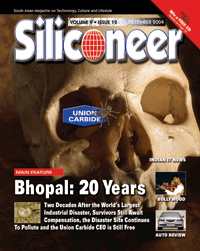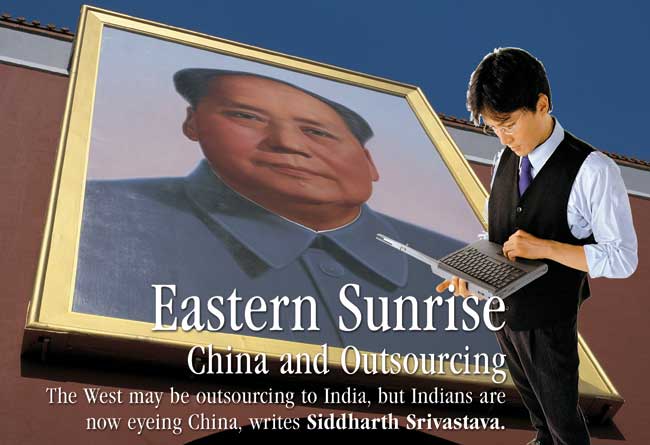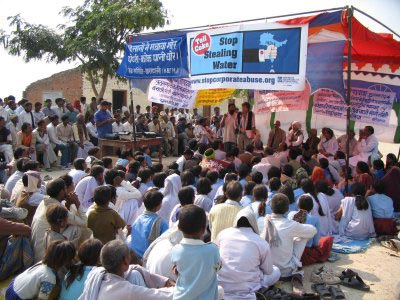|
|||||||||||||||||||||||||||
|
|||||||||||||||||||||||||||
|
|||||||||||||||||||||||||||
|
|||||||||||||||||||||||||||
|
|
|
|

DECEMBER 2004 |
IN THIS ISSUE |
|||||||||||||||
|
Publisher's Note
We champion the triumphs of science and technology, and revel in the strides India has taken in information technology, and cheer on as we have reported scientists who have thought of innovative ways to bring technology more relevant to the broader masses. But the terrible Union Carbide gas leak disaster in Bhopal 20 years ago is a sober reminder that at the end of the day, science is only as good—or as bad—as the human hands that guide it. The disaster and its aftermath are a sorry spectacle of corporate malfeasance, a shocking failure of the Indian government to protect the interests of its own citizens and a cautionary tale of how a failure of accountability can result in technology being the cause of misery rather than an enhancement of the quality of life. This month, on the 20th anniversary of the gas leak, we mourn the thousands that have died and express our solidarity with the hundreds of thousands who continue to grapple with the mess left behind. We also salute the tenacity, integrity and unflagging commitment of activists in Bhopal who have fought for justice for Bhopal survivors. These are the real heroes, along with the survivors, whether they are serving in a clinic in Bhopal, or organizing a protest in a U.S. campus. As the year comes to an end, we wish all readers happy holidays and a prosperous new year ahead. MAIN FEATURE Bhopal: 20 Years Later: The Misery Continues By Deepal Goyal Twenty years after the world's largest industrial disaster at the Union Carbide plant in Bhopal, disaster survivors have received a pittance. An Amnesty International report says the world has failed survivors of the murderous gas leak. Meanwhile, a new BBC investigative report says thousands remain at risk from toxics left behind at the plant, writes Deepak Goyal.  Mehboob Bi’s husband, Chand, worked as a mainte-nance worker for Union Carbide. Her youngest child died in her arms on the night of the disaster in 1984. Her son, Imran, died three years after his exposure to the gas and in 1999, she lost her husband after years of illness. She told the BBC she often asks: “Is Allah punishing me?” Mehboob Bi’s husband, Chand, worked as a mainte-nance worker for Union Carbide. Her youngest child died in her arms on the night of the disaster in 1984. Her son, Imran, died three years after his exposure to the gas and in 1999, she lost her husband after years of illness. She told the BBC she often asks: “Is Allah punishing me?”Shahid Noor’s father mowed grass at Union Carbide’s Bhopal factory. His parents were both killed by the gas leak, making Shahid an orphan at the age of 9. He still suffers breathlessness and dizziness today. Swaraj Puri was Bhopal’s chief of police. He wishes Union Carbide’s chairman, Warren Anderson, had lived in Bhopal at the time and had “been through what we’ve been through, seen what we’ve seen and suffered what we did.” These are but a few of hundreds of thousands lives that have been changed by the greatest industrial disaster in world history. On Dec. 3, poisonous methyl isocyanate gas escaped Union Carbide’s plant in the Madhya Pradesh capital of Bhopal, 3,000 people died on the night of the leak. At least 15,000 related deaths have happened since and survivors are still suffering chronic respiratory and other illnesses. In a scathing recent report, human rights organization Amnesty International says the world has failed survivors of the Bhopal gas leak.
Amnesty said overall, efforts by survivors to get proper justice through both U.S. and Indian courts had so far been unsuccessful. “The transnational corporations involved... have publicly stated that they have no responsibility for the leak and its consequences or for the pollution from the plant,” the report notes. Dow Chemical, the current owner of Union Carbide, denies any continuing liability either for the state of the Bhopal site or for the victims’ health. An eight-word statement on its Web site reads: “Dow never owned or operated the Bhopal plant.” Meanwhile, thousands of Indians around Bhopal remain at risk of poisoning 20 years after the disaster in the city, a BBC investigation has revealed. Although Union Carbide India Limited was responsible for cleaning up the site after the disaster, thousands of metric tons of toxic waste are still stored inadequately nearby, poisoning the town’s water supply. “We took a sample of drinking water from a well near the site,” a BBC report says. “It had levels of contamination 500 times higher than the maximum limits recommended by the World Health Organization. “The local people who drink this water every day are exposing themselves to a substantial chemical hazard associated, over time, with liver and kidney damage.” Union Carbide disputes the test results. The company says when it handed the site back in 1998 it “found no evidence of groundwater contamination.” When we presented details of the chemicals we found, it said it was “not aware of any evidence to support such claims.” But there are still thousands of tons of toxic waste on the abandoned and dilapidated site, lying in piles exposed to the weather, the BBC report said. “We found pools of mercury lying on the ground, skips full of poisonous material and in some sheds, chemical waste in bags that was still highly dangerous.” It’s not all bad news, though. Activists and protesters around the world are ready to take up the battle for the rights of Bhopal survivors. Students for Bhopal and its allies are coordinating a worldwide protest with students from more than 60 colleges, universities, and high schools worldwide organizing events to mark the 20th anniversary of the Bhopal disaster, and to demand that Dow Chemical resolve its legal and moral responsibilities for the “Hiroshima of the chemical industry.” The events, organized by Students for Bhopal, Association for India’s Development chapters, the Campus Greens and the Environmental Justice Program of the Sierra Student Coalition, represent the first mass student movement Dow has faced since its production of Agent Orange and Napalm during the Vietnam War. The events, which include several protests at Dow facilities, demonstrations, and educational events, stretch across five continents and on campuses throughout the United States. In University of Texas, Austin, members of AID-Austin have organized a three-day-long series of events. These include a day-long protest against university involvement with Dow, a hunger strike and candlelight vigil, and a film screening and open discussion about the disaster. In St. Benedict’s Preparatory High School in Newark, N.J., members of the SBP Environmental Club are planning to reenact the Bhopal tragedy, complete with the Grim Reaper and foaming dry ice. In Delhi University in India, members of the student group “We for Bhopal,” will release the report of its October 2004 Fact Finding Mission to Bhopal, for which students met with survivors, toured the factory grounds, and interviewed the chief minister of the state government and other officials. The students intend to deliver the report in person to the President and Prime Minister of India, following up on their meeting with the president in March. In addition, “We for Bhopal” is also organizing a massive candlelight vigil to mark the anniversary, and will be judging the results of its college essay competition. “Students are outraged,” said Ryan Bodanyi, the National Coordinator for Students for Bhopal. “They don’t want their colleges and universities associated with a corporation that maintains its profit margins by poisoning people and blithely standing aside as they die. Dow-Carbide’s callous disregard for the value of human life hasn’t changed much since the Vietnam War, and students aren’t going to be any more forgiving now than they were then. Dow-Carbide should expect these protests to continue and intensify.” More information of activists for Bhopal gas disaster survivors is available at the following Web site: www.bhopal.net - Deepak Goyal is a freelance writer. He is based in Kolkata |TOP|
INFOTECH INDIA  Tamil Nadu: Bullish on IT ... Intel May Make Chips ... Samsung, LG Dig Deep ... Sex Lawsuit Settled ... Mobile Horoscope ... BSNL, Reliance in Court ... Ambitious WiFi Plans ... Aim for the Moon: Kalam ... Alumina Project ... Laos-India IT Center — Here is the latest on information technology from India Tamil Nadu: Bullish on IT With Tamil Nadu growing 20 percent in the software and hardware sector during 2003-04, the state was poised to become the number one state in software exports within two years, the state IT Minister D. Jayakumar, claimed Nov 25. “Tamil Nadu has clocked 20 percent growth in software and hardware exports at nearly Rs. 8,000 crore for 2003-04, compared to Rs. 6,316 crore in the previous year,” Jayakumar said, while speaking at a seminar on “The Next IT wave, Opportunities and Challenges,” organized by CII in Coimbatore. Considering the growth, the software exports were likely to touch Rs. 10,000 crore mark during this fiscal and at this scale, the state will become number one exporter within two years, he claimed. Stating that Chennai and its suburbs continued to be the major software exporting locations in the state, he said exports from these locations stood at Rs. 7,557.64 crore, followed by Coimbatore region at about Rs. 85 crore. Four major companies — two each from banking and oil sector from the Middle East, have taken space and soon will shift its operations to Chennai, for their large outsourcing needs, particularly in the oil sector, Jayakumar revealed. The deal was struck during the visit of a delegation, led by himself, recently to Dubai, he said. The minister said Rs. 7 crore has been released to acquire land for the much awaited IT park in Coimbatore, where major IT companies, like Wipro and TCS, had already shown keen interest. As a highly progressive state, Tamil Nadu will now utilize the domain expertise to capture the emerging opportunities in the IT and BPO sectors, he said. Santa Clara, California-based Intel has a large development centre in Bangalore. The unit designs and develops software to power chips that drive computers and high-end networks for Internet-based applications. Intel, and global firms such as Motorola Inc., have heavily outsourced high-end functions like chip design to India to benefit from the country’s highly educated but low-cost software pool. Intel’s venture capital investment arm also has stakes in several Indian software firms such as Subex Systems Ltd. “The Indian market is growing rapidly and the mobile penetration rate is still low. It’s got great potential,” Song Sauk-hun, a Gartner analyst based in Seoul, told Reuters. “India is a market that Samsung and LG really care about because of the sheer volume that’s involved.” About 1.6 million users sign up each month, and the 45-million subscriber base is forecast to more than double by December 2005, with call rates as low as 2 U.S. cents a minute. Song estimates more than 37 million mobile phones will be sold in India in 2005, with the annual number likely to rise to 50 million by 2008. Korean firms entered India late, but Samsung quickly built market share with stylish phones and color screens aimed at the high-margin sector, while LG aimed for the low- to middle range. Nokia’s offerings cross the spectrum, but it has stuck mainly to low- to medium-priced bar phones. Infosys did not contribute any money to the settlement and was not a signatory to the settlement agreement, he said, adding that the company has learnt from its insurers’ counsel that the settlement releases Infosys from all claims and liabilities alleged in the lawsuit. Infosys has learnt from its insurers’ counsel that the insurers contributed 50 percent of the total settlement payments. Phaneesh Murthy paid the remaining 50 percent, since Infosys refused to make any contributions to the settlement. In career-related services on offer on 696, job vacancies, interview tips and best employers’ list were the options that greet the caller once he or she entered the menu. Vacancies were further classified as regional, national and international, and thereafter, demarcated by profession as IT, customer care, accounts, sales and marketing, etc., he said. Apart from predictions based on Vedic astrology and career-related information, customers can also access tarot card reading, he said, adding that the interactive consultation mode adopted by the service enabled a customer to ask questions related to education, health, finance, marriage, property and career. This service on 696 would be available at airtime charges of Rs. 9 per minute. Besides this, customers can access predictions according to their zodiac sign by typing the first three letters of their sign and SMS it to 8888 at a charge of Rs. 3, Vallath said. BSNL has said the Delhi High Court does not have the jurisdiction to entertain the petition filed by Reliance as the TRAI Act has categorically ousted the jurisdiction of the court to entertain such matters. The Delhi High Court had asked the BSNL to maintain status quo on the issue of interconnection agreement with Reliance until the court decided on the issue. The court had directed Reliance to deposit Rs. 400 million with BSNL. Different field units of BSNL have imposed a total of Rs. 2.55 billion on Reliance for passing international calls as local ones, thereby causing revenue losses to the PSU. The company has been focusing on providing wireless connectivity to the hospitality industry, public places and enterprises in the four metros, Bangalore and Hyderabad. Microsense has over 20 premium hotel chains WiFi networked across the country and is also networking over six new hotel properties, besides having plans to implement the networks in six luxury hotels in Sri Lanka through a wholly owned subsidiary. Microsense is also currently implementing several hundred public hotspots across the country and expects its network to grow to 1,000 locations in the next six months, officials said here. “With the business models in place and backed by our technology experience we are a full service provider for WiFi network solutions with custom built Operation Support Services including a suite of services such as authorization, authentication, billing, network management, and technology support through a 24 hour call centre,” N.V. Krishna, director, Microsense, told reporters. According to IDA, India generates the highest average income from each hot spot among Asia Pacific countries, and it estimates 500,000 hotspots in the country by 2010. “Moon belongs to the humanity and research on it must be based on international cooperation,” he said while delivering an inaugural speech at the sixth international conference on exploration and utilization of the moon. In a 35-minute slide presentation at the Darbar Hall of city palace here, Kalam advocated greater exchange program among young scientists and building up of a mechanism for getting support of deep space network. He also advised scientists to develop standards for payloads and “piggyback payloads.” Talking of various developments in space research, he said there was one million metric tons of helium on the surface of the moon. “Only 25 metric tons of helium could provide electricity to people on earth for one year,” he pointed out. Among others who addressed the inaugural session of the conference, which began scientific sessions Nov. 22, were the Rajasthan Governor Pratibha Patil and Prof. U.S. Rao, former ISRO chairman. The conference is being organized by the Physical Research Laboratory and ISRO. About 170 scientists, including 70 from abroad, took in the five-day meet. FFE Minerals India has secured five orders, making the company the primary technology supplier for feed preparation, calcinations and product handling at the Lanjigarh site in Kalahandi district of Orissa, he told a news conference here. The alumina project of Vedanta Group, promoted by Anil Aggarwal, is scheduled to be operational during the first quarter of 2006 and will have a capacity of 5,000 metric tons per day, Edge said. “The project is unique in that FFE Minerals will provide equipment and systems using all the technologies of group brought in from all over the globe,” he said. The Vedanta project is an integrated 1.4 million metric tons per annum alumina plant and part of the product is meant for Vedanta Group’s own new aluminum smelter coming up at BALCO, Korba, while the balance alumina quantity will be exported. Recounting that an MoU for the establishment of the centre was signed only two months ago, he said: “The speed with which it was set up would, I hope, provide the benchmark for all collaborative projects between our two countries.” Natwar Singh expressed the hope that the centre, with emphasis on capacity building and e-governance, will have a “multiplier” effect on development processes in Laos. The external affairs minister also inaugurated the Laos-India Entrepreneurship Development Centre here this evening. “This centre is part of our commitment to the initiative for ASEAN integration,” he said, adding three more such centers would also be set up in the capital of Cambodia, Myanmar and Vietnam by early next year. During his visit, Natwar Singh would hold bilateral consultations with his counterparts from various countries currently here for the India-ASEAN summit.
GLOBALIZATION
 Eastern Sunrise: China and Outsourcing - By Siddharth Srivastava The West may be outsourcing to Indiam but Indians are now eyeing China, writes Siddharth Srivastava. The outsourcing saga so far has proceeded along the following lines: Jobs in the U.S., mostly related to information technology, software and English-speaking customer support are being performed at lower cost and similar quality in India, which has garnered the bulk of the business. China is considered to be a potential threat with its big pool of cheaper engineers, but the main disadvantage has been the lack of an English speaking population, unlike India, which has a 300-year history of being a British colony, with English the first language of millions after the country’s independence in 1947. With the first mover advantage, Indian IT firms have established themselves in the global arena and are sought to deliver on crucial projects. However, the dynamics of the way the outsourcing business is being conducted is changing. Faced with rising business from the West, spiraling salaries of high cost employees who constantly hop jobs as well as a predicted shortage of skilled workers, Indian IT firms are doing the next best thing — outsourcing outsourced work from the U.S. to China, with the added advantage to leverage more intra-Asian business from Korea, Japan, Hong Kong and Taiwan. All the top Indian IT companies that vie for the outsourcing pool, such as Infosys, Tata Consultancy Services, Satyam Computer Services and Wipro have now established bases in China to meet the growing business demands from the West. TCS set up shop in China in 2002 with plans to employ more than 180 people; a year after making a foray into the country, Infosys (Shanghai) has a-staff strength of 200 to cater to clients in Europe, U.S. and Japan; Wipro set up its unit in August this year. Other multinational services firms such as Accenture, BearingPoint, IBM, and Hewlett-Packard have already running units in China. Intel employs some 3,000 people (majority of them engineers) at its R&D and assembly/test facilities in Shanghai while another assembly/test facility is under construction in Chengdu. In India, Intel has less than half the number compared to Shanghai at its R&D facility in Bangalore. It may be recalled that India has the lion’s share of the outsourcing market. According to research firm Gartner Group, the global IT services market is worth $580 billion, of which only $19 billion is outsourced, but India has 80 percent of this offshore market. The figure for outsourced IT services is expected to grow at a very rapid pace. The IT services market is broadly divided into two sections — the IT/Tech services which requires skilled manpower that China possesses and the business and process outsourcing segment which requires a knowledge of English and thus cannot be further outsourced to China. India garners the bulk of the outsourced BPO business as well. The one most important reason for IT business being driven to China is the cost advantage — China at the moment has an excess supply of well-trained engineers willing to work at wages lower than in India. Revenue from India’s IT exports was $12.5 billion in the year 2003-4 (March ended), up 30 percent from the previous year, which in turn has resulted in a 10-15 percent annual rise in wages in India’s software and back-office services industry. In turn, software export revenue for China in the year 2003 was just $700 million which leaves an over-eager and hungry-for-work, skilled workforce willing to work at a lower cost than India. This means that on an average an engineer with some experience in Shanghai can to be paid a monthly salary of less than $500 compared to over $700 in India and upwards of $5,000 in the Silicon Valley. According to estimates, China has 200,000 IT workers — compared with India’s 850,000 — with over 50,000 Chinese software programmers added to this pool annually. Evidence suggests China’s universities churn out upward of 250,000 engineering graduates each year, compared to 150,000 or so in India. There is an Indian connection here, too, with NIIT, India’s top technology training company, set up by the founder of the software exporter HCL Technologies, that opened its first training center in Shanghai in 1998, now having 121 centers in 25 provinces and training 25,000 Chinese annually. A recent study by KPMG study has predicted an acute shortage of IT personnel to the tune of 250,000 by the year 2009 in India. Thus, the numbers and economics works very well for increased forays into China by Indian IT firms. The impact of Indian IT firms moving to China is that it will still be a while before indigenous Chinese IT firms can really hope to compete with India on the global scale. With a head start of over 10 years Indian IT firms have reached scalability levels that will take a while for the Chinese firms to match. A second-rung Indian software firm employs over 15,000 employees compared to 3,000 employed by just a handful of IT firms in China. Experts estimate a minimum 3-5 year lag period before China can hope to even provide any competition to India. With Indian IT firms, with deep pockets, setting up shop in China, it will be even more difficult for resident Chinese firms to compete. The main problem remains the lack of knowledge of English and managerial capabilities, which makes it difficult for the Chinese firms to communicate and relate to international clients and push for more business even as competition stiffens. Indeed, with business expanding, the impending shortage of skilled IT workers, spiraling salaries, Indian software companies need an alternative low-cost center with ample supply of engineers to grow further. China is an excellent back-end for India’s IT industry. But the advantage may not last forever. As South Korea has shown to Japan in the automobile and consumer electronics industry, a nation can come from behind and overtake an advanced nation. With China aggressively promoting massive English literacy, the Indian outsourcing industry would do well to keep its eye on the ball. - Siddharth Srivastava is the India correspondent for Siliconeer. He is based in New Delhi. |TOP| OUTSOURCING:  Outsourcing Digest: Siliconeer presents of the latest news from the world of outsourcing. Carlyle Invests $10 Million... BPO Giant buys UK Firm... ICICI OneSource Buys U.S. Firm... Wipro, TCS: Move Over, IBM... Firm Gets $15m GM Order... Telstra Ships Jobs Amid Criticism... GM India Call Center... Teleopti Opens Office... Malaysian BPO Carlyle Invests $10 Million In what is billed as one of the first venture capital investments in the ePublishing services sector in India, Carlyle Group has invested $10 million in the Chennai-based Newgen Imaging Systems in the first round outside funding for the company. The nine-year-old Newgen Imaging is an integrated services provider addressing end-to-end needs of the ePublishing industry, handling the projects in books, journals, and reference works. Carlyle Group is understood to have picked up a substantial equity stake in the firm, which is estimated to have a top line of $5-6 million with a very high profitability. V. Prabhakar Ram, the core promoter of Newgen Imaging said, “We have not yet officially announced it. The deal is also not fully completed.” However, market sources confirmed the deal was inked a couple of weeks ago. Carlyle Group is one of the active investors in the IT sector and it earlier invested in companies like Financial Software Solutions, Quest and Usha Telecom. Newgen’s clientele include 12 of the world’s leading publishers across Europe and the U.S. With a combination of traditional typesetting skills and high-end ePublishing technologies, the company offers an attractive outsourcing proposition for the western world from India. It has close to 600 trained publishing professionals. Using fresh funds raised from VC investment, the company’s plan is to expand its operations by doubling its workforce over the next year. Global business process outsourcing major OfficeTiger, which has operations in Chennai, has acquired U.K.-based Devonshire Group for an undisclosed sum. Devonshire Group is a provider and consultant of outsourced creative, document and staffing solutions to professional service firms in the U.K. and Europe. Established in London in 1992, Devonshire Group has $20 million in annual revenues and over 200 clients in the financial, legal, consulting, design and pharmaceutical verticals, apart from top 500 corporates. Devonshire has a team of 250 personnel in London and 40 in its Frankfurt operation, and with the acquisition, OfficeTiger’s total headcount rises to about 2,500 across the world. OfficeTiger has appointed Amanda White, former chief executive officer of Devonshire Group, as its managing director for European operations. Headquartered in New York City, OfficeTiger has operations in U.K., Germany, India and Sri Lanka. ASG specializes in third party debt collections and its clients include three of the top 10 credit card issuers in the United States. ASG currently operates two centers in Buffalo, New York and has over 500 employees. Its revenues for the year ended Dec. 31, 2003 stood at $25.14 million. Its proven expertise is backed by a strong management team with more than 50 years of collective experience in the financial/banking industries. The acquisition will add late stage collections capability to ICICI OneSource’s service offering. Collections represent a $16 billion opportunity in the United States alone. Ananda Mukerji, managing director and CEO, ICICI OneSource, said, “The acquisition is in line with our strategy to aggressively expand our service offering and continuously deliver value to our clients. We have identified collections as a high growth area and this acquisition gives us a platform from which to offer the most complete collections solution to our clients. We can now offer a full suite of collections capabilities: customer acquisition, billing, customer service and collections.” ASG president and CEO Tony Frisicaro said, “We set up ASG nine years ago and since then our actions have always been dictated by the best interests of our employees, our clients and the long-term interests of our business. Today, we are delighted to become part of the ICICI OneSource family. We have taken ASG to a juncture where it will benefit greatly from ICICI OneSource’s financial strength and expertise. ICICI OneSource’s client relationships with FTSE 100 and Fortune 500 companies will help us grow aggressively from this point on.” ICICI OneSource announced that Tony Frisicaro will head the collections business for the company globally. There will be no change in the management structure of ASG and all 500 employees will continue with their current jobs. This acquisition is expected to create additional employment opportunities in the U.S., especially in Western New York. While the outsourcing industry debates whether these announcements could trigger a trend or amount to just a blip on the radar, research by financial services consulting firm TowerGroup says the answer lies somewhere in the middle. “Two scrapped deals alone are not proof of a broader anti-outsourcing trend in the financial services industry,” said Virginia Garcia, senior analyst at TowerGroup and author of the research. “But they undoubtedly flash a signal of underlying market dynamics that may shift the balance of some current contracts, rendering them less attractive to the institution than originally envisaged,” she said. “This will help bring positive change, increase competition in the supplier market and yield more efficient sourcing strategies for financial services institutions.” Traditional outsourcers such as IBM, CSC, and EDS will have to make increasing room for non-traditional offshore vendors such as Infosys, Wipro and Tata Consultancy Services, her study adds. The Boston, Massachusetts-based consultancy says the global financial services industry terminates only four percent of outsourcing contracts above $250 million and mergers are often the culprits. The broader outsourcing market, the study notes, will continue to grow at a healthy clip of 12 percent annually. The GM order is to the tune of $15 million (about Rs. 70 crore). It is, however, not yet clear whether Nucleus Software will implement the order on its own or will work jointly with other Indian software companies. The technological details about the order were not immediately available. When contacted, senior executives of Nucleus Software refused to comment on the issue. GM, which is estimated to have an annual IT budget of $3 billion, has been relying on software bigwig EDS for close to two-thirds of its IT requirements. EDS, which was a unit of GM for over a decade till 1996, had a long-term contract which is set to expire in the middle of next year. And GM is believed to open up a bidding process for a 10-year IT contract by the end of this year. Almost all tech bigwigs are vying to get a share of the mega-contract. EDS, which gets about 10 percent of its revenues from GM, is quite confident of keeping a significant portion of the business from its largest customer when that contract is up for rebid in 2006. Moreover, there is a worldwide trend towards shifting IT jobs to India, he said, adding, “I am not at all surprised that providers to Telstra are on that path.” Telstra had announced it had renewed a “global delivery” contract worth up to $100 million with EDS Australia to manage its landline billing systems with the proviso that it transferred 400 jobs to India over the next 15 months. The move is a part of the company’s plans to save $700 million in technology costs. In January, Telstra had come under fire over its plans to move 450 jobs to India. Lashing out at Telstra for shipping local jobs to India, Community and Public Sector Union assistant national secretary Paul Ingwersen said, “These jobs are in addition to those that went offshore earlier this year.” “There is no honesty here from Telstra or the federal government, who are a major shareholder. It should have been out in the open that the government supported Telstra shipping jobs offshore. Federal treasurer Peter Costello should have brought Telstra into line on this because it undermines our IT industry,” Ingwersen told daily The Age. A spokeswoman for Information Technology Minister Helen Coonan said outsourcing was “an operational issue for Telstra based on commercial considerations.” “It is disappointing, and the government does not like to see jobs go offshore, it’s a two-way street,” Coonan said. EDS spokeswoman said Telstra’s wish to streamline services would mean billing services will be provided at EDS offshore in India. She told national daily The Australian that employees had known this has been on the cards for a while and the company would provide them with options of redeployment and training opportunities. Starting with the National Capital Region in Oct. 20, the centre will be run by GMI and would not be a select dealer-driven activity. The customer care centre would be the face of GMI, eventually encompassing all facets of in-bound and out-bound relationship servicing and marketing, he said. Anyone calling 3030-8080 from anywhere in the country would be charged only for a local call with all distance charges being borne by the company. The Indian arm of the world’s biggest carmaker sold 3,207 cars in September, the highest in a month since its inception. It also sold 1,062 units of Chevrolet Optra. Sandeep Sudhir, head of the office, is working closely with 3D Networks, a leading solutions integrator and a part of Planet One Ltd. 3D Networks and Teleopti have signed an agreement where 3D Networks will distribute and implement the workforce management solution Teleopti CCC in India. 3D Networks as well as Teleopti have a close relationship with Nortel Networks, company sources added. Teleopti Contact Center Coach is a complete solution for workforce management, including revolutionary tools for a step-by-step approach to customer service driven schedules. The solution includes multi-skill, multi-channel and outbound contacts. Apart from India, Scicom manages customer support for Nokia in the Asia Pacific region. The Indian subsidiary would focus on Nokia’s Indian clients only, said Scicom group executive director and CEO Leo Ariyanayakam. He, however, declined to divulge investment details and specifics on call handling capacity of the Indian centre. APPROPRIATE TECHNOLOGY: Technology for People: Tech Awards 2004 - A Siliconeer report Dr. Ashok Gadgil (inset) of the Lawrence Berkeley National Laboratory won a $50,000 Tech Award developing UV Waterworks, a quick, low-cost system to disinfect drinking water in poor regions around the world. A Siliconeer report.
Among the 2004 Tech Museum Awards cash prize recipients was: Dr. Ashok Gadgil of the Lawrence Berkeley National Laboratory received the Affymetrix Health Award for UV Waterworks, a quick, low-cost system to disinfect drinking water in poor regions around the world. Berkeley, CA, United States – www.waterhealth.com Gadgil and the other laureates — Dr. Kenneth Owens, Jr. and Paul Burgess of Humboldt State University, International Development Enterprises, Andrew Lieberman of Asociación Ajb’atz’ Enlace Quiché and Rodrigo Baggio of the Committee for the Democratization of Information Technology — have been each awarded a cash prize and they are encouraged to reinvest their winnings in additional innovative programs that utilize technology to solve global challenges and improve the lives of people around the globe. In December 1992, an outbreak of a new and particularly dangerous strain of cholera began in southeastern India. Dubbed “Bengal cholera,” within months it had spread throughout India and into neighboring countries, killing up to 10,000 people. The tragedy inspired Gadgil to look for a new way to purify drinking water. Using science no more complex than the ultraviolet light emitted by an unshielded fluorescent lamp, he built a simple, effective, and, most important, inexpensive water disinfection system. Born in Bombay, India, in 1950, Gadgil was interested in science from a very early age. Though Gadgil’s parents wanted him to become a doctor, he thought it would be “extremely boring to be doing the same thing all your life.” Instead, he chose to pursue physics. He received his bachelor’s and master’s degrees in physics in India and then, in 1973, came to the University of California at Berkeley to continue his studies. At Berkeley, Gadgil explains, “Two things really struck me. One was the high level of affluence in the U.S. The second thing was getting a sense of how important it is to have science applied to address problems that are societally significant. . . . The basic science is well understood, but nobody had bothered to take the final step to convert that into a useful technology.” During the summer of 1993, Gadgil and a graduate student investigated the effectiveness of UV light and whether it was economically feasible. “We were completely amazed,” he says. “Using the simplest engineering, we could disinfect water for half a cent per ton. That’s shockingly cheap. You could disinfect one person’s drinking supply for a full year for a couple of cents.” From his experiences in India, Gadgil knew that any system would have to require little maintenance and not take for granted basic infrastructure like electricity and water pressure. The system he and his student built, later named UV Waterworks, is remarkably simple. In a compact, enclosed box, a UV lamp is suspended above a shallow pan. Water runs into the pan under the force of gravity, where it is exposed to the UV light, then into a holding tank. The only power that is needed is about 40 watts to power the light; this can come from a car battery. The system can disinfect four gallons of water a minute, killing 99.999 percent of bacteria and viruses. This produces enough clean water to serve more than 1,000 people. Water Health International, the company founded to bring the technology to market, now makes several different versions of Gadgil’s disinfection system, for small and large applications, for emergency use, and for locations that also need to filter out silt and other large contaminants. Prices start at about $1,500. UV Waterworks systems have been used in India, South Africa, the Philippines, Honduras, and other countries. Since 1998, the Mexican government has installed about 100 in Guererro, a state on the Pacific in southwestern Mexico. The results have been very positive. In the summer of 2000, Gadgil reports, people from Water Health International returned with stories and data showing a dramatic decline in the incidence of diarrhea among children and adults. And preventing deaths and illness are just the most visible effects of purifying water—it also protects children from stunted physical and mental growth. “This is the kind of story that really makes my day, really makes me happy,” Gadgil continues. “It makes me feel good when I get up in the morning.” CONFERENCE: Presenting Bangladesh: AABEA Convention - A Siliconeer Report American Association of Bangladeshi Engineers and Architects hosted its 20th Anniversary Biennial convention on ‘Presenting Bangladesh: Roles and Opportunities to Create a Success Story in the 3rd World.’ A Siliconeer report.  Bangladeshi banker Iqbal Quadir created waves in the 1990s by coaxing Western investors into pouring money into a project to benefit villagers in Bangladesh by bringing arguably the most state-of-the-art tool—the cell phone. Grameen Phone is now a business with over $200 million revenue. Bangladeshi banker Iqbal Quadir created waves in the 1990s by coaxing Western investors into pouring money into a project to benefit villagers in Bangladesh by bringing arguably the most state-of-the-art tool—the cell phone. Grameen Phone is now a business with over $200 million revenue.Quadir, who now teaches at Harvard’s Kennedy School of Government, delivered the keynote speech Nov. 20 in Santa Clara at the 20th anniversary biennial convention of the American Association of Bangladeshi Engineers and Architects. The theme was “Presenting Bangladesh: Roles and Opportunities to Create a Success Story in the 3rd World.” The convention was held in the heart of Silicon Valley at the Santa Clara Convention Center. “This was a celebration of Bangladesh, outlining opportunities for U.S.-based entrepreneurs and technical experts to create success stories in Bangladesh,” an AABEA press release said. “Welcomed by the Mayor of Santa Clara and the Bangladeshi Consul General from Los Angeles, American Bangladeshis and well-wishers of Bangladesh from all across the U.S. participated in this in-depth exploration of technology-driven development. Quadir’s keynote speech set the tone of the meeting by showing how technology can create both development and business opportunities by increasing productivity of the masses. Bullish yet objective, Qadir narrated how one man’s Herculean effort furthered the cause of “Grameen phone” in the face of all daunting odds. His talk instilled fresh inspiration into a host of Non-Resident Bangladeshis who are already mulling ways to make a difference for their country. The morning parallel sessions underscored the relevance of image and branding for Bangladeshi operations courting to gain foothold in the global IT market. The afternoon sessions offered multiple technical updates on a variety of topics ranging from device processing and biotechnology to business competitiveness, architecture and technology transfer. “Each one of the sessions were implemented with manifest attention to details — both on the selection of the content and the quality of speakers,” the release added. “The last session in the afternoon, aptly moderated, featured the ‘Readiness of Bangladesh market for Outsourcing’ and had the audience and the panel deeply engaged.” “Didar Alam, an accomplished entrepreneur flew in from Bangladesh. He rejuvenated the entire audience with his bold yet articulate style of a success story weaved in a pattern of utmost patriotism and a winning vision. The evening program offered a sumptuous dinner and an enthralling stage-drama performed by Bangladesh Theater.” Although an association of engineers and architects, the topics covered in the convention ran the gamut. Haider A. Khan, professor of economics at the University of Denver and who once worked for the Asian Development Bank, reflected on his own research to ponder why, despite objectively favorable conditions, Bangladesh has failed to attract substantial foreign direct investment. He suggested a policy package for Bangladesh policy makers to remedy the deficiency. The environment was a big issue, particularly arsenic poisoning. Loyola Marymount University mechanical engineer Prof. Rafiq Noorani talked about his experience on working on project to design and construct a pilot project in Bangladesh that will purify arsenic-laden water. On the other hand Ferdous Alam and Jeff Stevenson talked about the experience of Bangladesh ICT Business Center in Silicon Valley. Set up in March last year with the aid of the World Bank and the Bangladesh government and backed by AABEA, the speakers talked about how BIBC has used firms like SalesTeam1 and Certified Outsource, Inc. to lure outsourcing work to Bangladesh. BIBC is also finding new ways to help Bangladeshi firms learn about doing business in the U.S. and encouraging small groups of non-resident Bangladeshis to open business channels in Bangladesh. InternetSpeech CEO Emdad Khan pointed out that with an abundance of choices, it is become increasingly difficult to attract, capture and retain customers in the outsourcing field. His advice is clear: To participate successfully in the highly competitive global market, it is imperative that Bangladesh and its globally-focused industries be conscious of the importance of establishing and maintaining a brand identity. Khalid Azim, who works with San Jose, Calif.-based SIRF technology, said the economic fundamentals of IC development provide a strong impetus for companies to relocate their chip design activities to low cost overseas centers, so if Bangladesh can get its act together, it has much to gain. “The takeaway message from the conference was one of sheer optimism,” the AABEA press release said. “The dream of many for a successful endeavor in Bangladesh is fast becoming reality, and success will come only with dogged perseverance, unswerving grit, and unflinching courage— any takers?” |TOP|
REPORT: Get Real, Coke: Water Rights Protest - A Siliconeer Report  Activists have launched a movement against beverage giant Coca-Cola, accusing the company of draining water from some of the world's poorest communities. A Siliconeer report. Activists have launched a movement against beverage giant Coca-Cola, accusing the company of draining water from some of the world's poorest communities. A Siliconeer report.LEFT: Protest against Coke in San Francisco. BOTTOM: Protest against Coke in India Consumers and activists have called on Coca-Cola to stop draining water from some of the world's poorest communities, according to a press release from activist group Corporate Accountability International. “Community leaders, religious leaders, students and educators (San Francisco in the Bay Area) spoke out against Coke's abusive practices in India and delivered thousands of public comments to Coke corporate headquarters in Atlanta and regional headquarters in Oakland, Calif., the release added. “These local activists took part in an international day of action telling Coke to stop stealing water. “Similar events were held in seven cities across the  The release says that as a result of Coke's water extraction, at least five communities across Coke gets away with its abuses because of its tremendous economic and political clout. From Reverend Alexandra Childs of the United Church of Christ delivered the public comments to Coke's Coke's practices are part of a much larger problem of corporations contributing to a global water shortage, the release says. The United Nations estimates that two-thirds of the world's population will not have enough water by 2025 if current trends are not reversed. According to a former Vice President of the World Bank, “The wars of the 21st century will be fought over water.” Coke's water depletion contributes to this problem and is making water shortage a reality right now for some communities. |TOP|
North Carolina’s Bhaskar Mookerji (inset above, left) and New York’s Samir Zaidi (inset above, right) are among six individual’s vying for the top $100,000 prize for the Siemens Westinghouse Competition in Math, Science & Technology, one of the most prestigious science prizes in the U.S. for high school students. Siliconeer wishes them good luck!
Thousands of bright high school students compete all over the U.S. for the Siemens Westinghouse Competition in Math, Science & Technology which “recognizes remarkable talent early on, fostering individual growth for high school students who are willing to challenge themselves through science research,” according to the Web site of the Siemens Foundation, the sponsor of the competition. “Through this competition, students have an opportunity to achieve national recognition for science research projects that they complete in high school. It is administered by The College Board and funded by the Siemens Foundation.” At each of six regional competitions an individual and a team have been selected as Regional Winners. These students receive scholarships of $1,000 each as a regional finalist (including team members) and $3,000 each as an individual regional winner. The winning team receives $6,000 to be divided among team members. Southern Region Silver Medal winner Bhaskar Mookerji, from the North Carolina School of Science and Math in Durham, N.C., and Middle States Region Silver Medal winner Samir Zaidi, from Hackley School in Tarrytown, N.Y. have won their respective regional contests and are now eligible to compete in the finals in the first week of December in Washington D.C. In the national competition, students’ presentations are judged by research scientists recruited for their specific expertise in the area of research for each project. The top individual and team winners receive additional scholarships of $100,000. Runners up receive scholarships ranging from $10,000 to $50,000. Successful competition participants may apply for valuable internships at Siemens operating companies. Bhaskar Mookerji’s project focused on the fundamental coordination chemistry of zinc. Mookerji created and characterized new chemical compounds that could potentially serve as a stepping stone for the pharmaceutical industry and across a number of other applications. He extended the study of organometallic compounds known as poly(mercaptoimidazolyl)-borates to the largely uninvestigated phenylbis (mercaptoimidazolyl)borates. In the process of his research he also discovered a metal bonding sphere of zinc and a potential model of an enzyme used in the production of DNA nucleic acids. Mookerji, a senior, is fluent in Bengali and Spanish. He is co-founder and co-president of the NCSSM Debate Team and is a member of the National Forensic League, the Charlotte C.A.N. (Computer Access to Neighborhoods), the NCSSM Model United Nations Team and the Myers Park Interact (service-volunteer group). His hobbies include public speaking, cinema, reading and chess. He plans to study chemistry and applied mathematics in college and would like to become a research professor of physical sciences and mathematics. Mookerji’s mentors on this project were Dr. Daniel Rabinovich, associate professor of chemistry at the University of North Carolina at Charlotte and Dr. Myra Halpin, research chemistry instructor at the North Carolina School of Science and Mathematics. Samir Zaidi’s research could lead to new measures to help prevent post-menopausal osteoporosis. Results from his project have shown that elevated follicle-stimulating hormone (FSH) levels contribute to post-menopausal osteoporosis. Previously, such bone loss has solely been attributed to failing ovaries and reduced estrogen levels. Zaidi’s study found that blocking the action of FSH on the osteoclast, the cell that resorbs bone, might provide a means by which osteoporosis and its associated fractures can be prevented. His grandmother, who suffers from osteoporosis, inspired him to pursue this area of research. His mentor was Dr. Li Sun, assistant professor of medicine at Mount Sinai Medical Center. Fluent in French and Hindi, Zaidi, a senior, is on the Community Council at Hackley School. He is also the senior class president. His hobbies include tennis and squash. An accomplished violinist, Zaidi is first violinist of the Hackley String Orchestra. He plans to study molecular research in college. In addition to six individuals, six teams have also made it to the finals in Washington. One of them is the team of Alex Thachara from The Wheatley School in Old Westbury, N.Y. and Allyson Ho from William P. Clements High School in Sugar Land, Texas. REAL ESTATE: A Possible Bargain: Foreclosed Properties - By Srini Saripalli   In the superheated San Francisco Bay Area property market, foreclosed properties are available at as much as 40% below market value, writes Srini Saripalli. In the superheated San Francisco Bay Area property market, foreclosed properties are available at as much as 40% below market value, writes Srini Saripalli.The last few months of a calendar year are considered sluggish for transacting real estate, but Silicon Valley seems to be an exception to this. Properties are appreciating rapidly at this time of the year and this year has been one of the best years for selling real estate. Understanding the marketplace and rationalizing the escalating prices has become difficult for investors and homebuyers. At a time when real estate prices are soaring there are still many opportunities to buy properties that are 30 percent to 40 percent below market value. Foreclosures are one of the best ways to find great bargains. So what is a foreclosure? A foreclosure is a legal process that a lender initiates after the borrower fails to repay the loan as per the terms of the contract. The lender initiates the foreclosure process to reclaim the possession and ownership of the property. For example, let’s say a borrower has a mortgage of $1 million on his property that is worth $1.5 million. Let’s assume monthly payments on a $1million mortgage are about $9,000. If the borrower misses three consecutive monthly payments, then at the end of the 90th day or third month the lender will file a “Notice of Default” at the county recorder’s office. This is the notice that indicates pending foreclosure proceedings. It also indicates the auction date. At this time the borrower will have the following options: • Pay off all the back payments, penalties and legal fees if any and make the loan current As the borrower in the example has equity of $500,000 he can convert a part of that to cash by re-financing the property. Re-financing a property in foreclosure is usually difficult. • Sell the property and payoff the mortgage, provided the proceeds from the sale equal or higher than the mortgage amount. The opportunity to buy a pre-foreclosure property opens the day the “Notice of Default” is filed. The opportunity ends on the day the property is sold at the auction. The time between these two events enables a buyer to work with the homeowner and the lender to negotiate and structure a deal that could be extremely profitable. This is the only time in the entire foreclosure process where the buyer can use conventional mortgage, hard moneylenders or creative financing techniques to buy the property. Once a “Notice of Default” is filed it becomes public information, and usually there is a lot of competition from other investors due to this filing. Hence to avoid competition experienced investors use various farming techniques to spot owners before the “Notice of Default” is filed. Properties can also be bought in auctions at bargain prices too, but one would need cash for the purchase. Bidding in an auction sale is extremely risky and one needs lot of experience and skill. Once a borrower defaults on a loan his credit is at serious risk. A foreclosure stays on the credit report for a minimum of seven years. This is the prime reason why people who have defaulted their payments are extremely motivated to avoid a foreclosure proceeding. Borrowers in foreclosure are sometimes difficult to deal with, as they are confused and scared. Their self-esteem is low and they are in need of support from someone who understands the process. As a buyer your motive should always be to help them in their tough times. If any time during the transaction a seller perceives that you are taking advantage of his or her situation, he/she always walk away from the deal. - Srini Saripalli is a real estate investor and business development consultant to |TOP| Photo Essay: Diwali in Sunnyvale: A Siliconeer photo essay 
The Sunnyvale Hindu temple celebrated Diwali Mela Nov. 5-7. Highlights included performances by Bollywood stars, dance items by kids, food and trade booths, childrens’ rides, and Antakshari, a popular Hindi TV show hosted by Anu Kapoor. Richa Sharma and pop star Anaamika also performed to a record audience. About 20,000 people attended the three-day event according to temple officials. (All photos by Sunnyvale Hindu Temple) Key to Photos:
|TOP| ENTERTAINMENT: Here Comes STAR! : A Gift from Directv - A Siliconeer report Indian channels like Zee TV and TV Asia have been ruling the roost for Hindi television buffs in the U.S. Not any more, as India’s most popular satellite channel, Rupert Murdoch’s STAR, enters the fray with a slew of channels. A Siliconeer report.  Digital television service provider El Segundo, Calif.-based DIRECTV, Inc Nov. 17 announced the launch of new South Asian programming from Hong Kong-based STAR Group, according to a press release from the company. Digital television service provider El Segundo, Calif.-based DIRECTV, Inc Nov. 17 announced the launch of new South Asian programming from Hong Kong-based STAR Group, according to a press release from the company. Four STAR Indian channels — STAR PLUS, STAR ONE, STAR NEWS and VIJAY — are now available from DIRECTV. The United States logos for STAR PLUS and STAR NEWS will incorporate the word “India” to denote the Indian origin of the programming. DIRECTV will also launch CricketTicket, the first-ever season-long subscription TV package for international cricket, which offers DIRECTV customers cricket matches from around the world, beginning Nov. 17. “The South Asian population in the United States, with more than two million people, is one of the fastest growing communities and will now have access to the same top-rated, high-quality programming that is available in India,” said Mitchell Stern, president and CEO, DIRECTV. “We are delighted to be able to provide programming for our South Asian viewers that is informative, entertaining and relevant to their lives. These are the first of several international channels that we are rolling out and we are looking forward to providing our ethnic customers with the most compelling programming lineup available.” STAR CEO Michelle Guthrie said, “We are excited to bring STAR’s innovative and record-breaking Indian programming to viewers in the United States. Our relationship with DIRECTV will enable more people to enjoy the shows that have made us a household name in India and it is in line with our aim of expanding and strengthening our distribution. I have no doubt that our Indian channels, popular already in countries outside of India such as the U.K., Middle East and Singapore, will be well-received in the United States.” The multi-year agreement with STAR Group Limited brings to viewers in the United States the top-rated programs that have made STAR the leading cable network in India. The STAR lineup features popular dramas, comedies, game shows, news and documentaries. STAR PLUS (channel 2001), STAR ONE (channel 2003) and STAR NEWS (channel 2002) are broadcast in Hindi and VIJAY (channel 2004) is broadcast in Tamil. STAR PLUS, India’s number one cable channel for the fourth consecutive year, with its mix of popular Hindi entertainment and dramas, attracts 50 million viewers every week in India. STAR ONE, a new Hindi general entertainment channel targeted at young, urban audiences, features a wide array of programs across a range of genres such as action/thrillers, comedy, drama, youth, game/format shows, lifestyle and original movies made for television. STAR NEWS offers viewers 24-hour Hindi news that covers the full spectrum of news ranging from politics to business, investigative reports to consumer issues and crime to the environment. VIJAY programming is tailor-made to cater to the distinctive culture of Tamil Nadu, featuring innovative reality shows and popular entertainment programs. The new STAR channels are available to both DIRECTV residential and commercial customers. The HindiDirect residential package that includes STAR PLUS, STAR ONE and STAR News, is $29.99 per month. The TamilDirect residential package (STAR VIJAY) is $14.99 per month. DIRECTV has completed licensing agreements with the Australian Cricket Board, the United Cricket Board of South Africa, the New Zealand Cricket Board and the Zimbabwe Cricket Union, which gives DIRECTV access to all international cricket being played in those countries over the next four years. DIRECTV will offer customers access to all of these matches via the DIRECTV CricketTicket package. The inaugural CricketTicket season began Nov.17 and concludes March 31, 2005. The package is available for $199, which includes more than 120 days of cricket through next spring. All new international programming will be broadcast from the 95-degree West Longitude orbital slot, requiring customers to use a new 36-inch dish capable of receiving programming from 95 degrees WL, as well as DIRECTV’s primary orbital slot at 101 degrees WL. In some markets, customers who subscribe to a local channels package will require a second smaller dish. STAR, a wholly-owned subsidiary of News Corporation, is Asia’s leading multi-platform content and service provider. STAR’s over 40 television services in seven languages reach more than 300 million viewers across 53 Asian countries. DIRECTV is the nation’s leading and fastest growing digital television service provider with more than 13.5 million customers. EVENT: South Asian Cinema: Two Reviews The recent South Asian film festival by Thirdi in San Francisco was a desi film buff’s delight. Siliconeer reviews two of the films.  JUKTI TAKKO AR GAPPO Director: Ritwik Ghatak Starring: Ritwik Ghatak, Tripti Mitra, Shaoli Mitra and Utpal Dutt. [India, 1974] Running Time: 118min B&W 35mm print from the British Film Institute In Bengali with English Subtitles (Inset: A Scene from “Jukti Takko Ar Gappo”) Ritwik Ghatak, in some ways, is the enfant terrible of Bengali cinema. The man was considered talented, even, brilliant, but too self-destructive and erratic, and in the end he obligingly proved his critics right by dying prematurely, an alcoholic wreck. That’s what makes Jukti Takko Ar Gappo, his last film, such an unnerving, even haunting film despite its uneven quality. Even his most ardent fans wouldn’t argue that this was anywhere near his best work, there’s his celebrated trilogy of Meghe Dhaka Tara, Komol Gandhar and Subarnarekha, then there’s his exquisite film on a taxi driver’s love affair with his rickety car, Ajantrik. But despite all that, watching the film is an emotionally draining experience for anyone familiar with those terrible ’70s in West Bengal – massive poverty, unemployment, an insurgent radical left movement that was violent and suppressed with a ferocious brutality, and a general, scary crisis of faith. Jukti, Takko Gappo captures that time with searing honesty, and to his credit, Ritwik does not spare himself either. Bangladesh has just been born out of a murderous war, in West Bengal, the Maoist Naxalite insurgency and massive unemployment have created a crisis of faith. Ritwik plays Nilkantha Bagchi, a failed alcoholic author who is disillusioned with his life and his environs. The uncannily autobiographical, reflective story shows him traveling through Bengal, deep into the fabric of his past life, loves, and friendships. He travels with a Bengali refugee, an unemployed trade unionist and a penniless teacher of Sanskrit. The encounters and adventures that transpire during the pilgrims’ painful progress, lays bare Ghatak’s disillusionment with organized politics and profound loss of his faith in society and himself. Along the way, he comes across a talented author who has sold out to commerce and is now a successful hack, a tribal artisan who struggles as the need for his craft is on the wane, and has a run in with armed radicals with whom he has a passionate exchange of views—both critique society with equal bitterness, yet there is a deep lack of understanding on each side for the other. Oops. All hell breaks loose as Mishra tries to reassert control. Meanwhile, Hire can’t keep her mind (or hands) off the son of a Muslim family friend with whom she has had a tortured but passionate on-again, off-again relationship. It’s high drama and hijinks all the way as the Mishra patriarch fires his most trusted Muslim colleague for decades and the latter commits suicide, while various characters are getting in and out of bed in the bewildering fashion of any self-respecting daytime soap. Fast-paced, deliciously soap-operaish in parts, it’s a gripping glimpse, nevertheless into the life of second generation of South Asians. Bengalis will wince at how the language is butchered during the mercifully scarce Bengali dialogues, but it’s a small price to pay for an absorbing look into the British desi diaspora. |TOP| COMMUNITY NEWS IN BRIEF: Consultant to Bustamante ... Spread India Marks Deepavali ... Sacramento’s Indian Chamber Celebrates Diwali ... Getting into College: Insight ... Exporter of the Year ... ICC Raises $286,000 ... Indian Christmas Tree ... D’Souza Family Honored Consultant to Bustamante Calif. Lt. Gov. Cruz Bustamante has appointed Ravi Kahlon to the position of policy consultant on his Sacramento staff. Kahlon will oversee economic development, small business, insurance, health and trade issues. She also will serve as the lieutenant governor’s liaison to Californians from Pacific Rim communities.
Kahlon’s past experience includes working as a legislative assistant to Assemblyman Manny Diaz, D-San Jose, and the former Majority Floor Leader, Sen. Richard Polanco, D-Los Angeles. While on Sen. Polanco’s staff, she was lead coordinator for an exhibit on the Mexican and East-Indian experience in California, which is on the Latino Caucus Web site. She also was a voter-outreach specialist for Citizenship Action Network, working primarily in Latino, Indian and Muslim communities. Kahlon was graduated from the University of California, Davis, with a degree in philosophy and a minor in women’s studies. While a student, was a participant in the gender global studies program teaching self-sufficiency skills to poor women in New Delhi, India. She is a native of Yuba City. Her grandparents, Naranjan Singh Sohal and Surjit Kaur Sohal, were among the first Punjabis to immigrate to the Yuba City area. She currently resides in Folsom and is an avid bicyclist. |Return to Community News Index| |TOP| Spread India Marks Deepavali
About 350 participants attended, and about $40,000 was raised via incoming pledges and donations. “Spread India” stands for Society for the Promotion of Rural Environment And Development of India (www.SpreadIndia.org). The non-profit organization’s mission is to provide under-privileged children with an opportunity to gain the lifelong gift of education. Chief guest Dr. Gavva Chandra Reddy, an oncologist, made an inspiring speech on the subject of illiteracy and its impact on health system. Interested readers can find more information on the organization at its Web site at: www.SpreadIndia.org |Return to Community News Index| |TOP| Sacramento’s Indian Chamber Celebrates a Traditional Diwali
The event was attended by members of different Asian communities, including the Chinese, Muslim and Sikh communities.
“The JQ American Corporation is an outstanding example of what a small business can achieve in the export marketplace,”said Don Gallion, chairman of the National District Export Council Steering Committee. “Companies such a JQ American comprise more than 97 percent of U.S. exporters, and represent some of the best in entrepreneurial ingenuity and innovation.” JQ American, a minority-owned firm, specializes in the supply and distribution of products and services to industrial and oil, laboratory, medical, pharmaceutical and chemical institutions. Founded in 1998 by Mr. Jamal Qureshi, the company reports that exports account for nearly 90 percent of its total sales, and it currently markets to 15 countries. |Return to Community News Index| |TOP| ICC Raises $286,000 Anil Godhwani, India Commu-nity Center co-president and co-founder, announced Nov. 12 that ICC’s supporters helped raise over $286,000 for the Kids Excellence Programs at the first annual banquet and auction Nov. 6 at Palo Alto’s Crowne Plaza Cabana Hotel. Celebrities like Bollywood stars Suniel Shetty, Shabana Azmi, Kim Sharma, Sandhya Patel — ABC7 Weather Anchor, Raj Mathai — NBC11 sports director, Miss California Veena Goel and Miss Teen India America Sasha Hoffman attended the event. Talat Hasan, ICC’s chairperson of its board of trustees, added, “Proceeds from this event will go towards ICC’s Kids Excellence Programs to benefit three main areas. ICC will be sponsoring youth scholarships which will be announced Feb. 26 at ICC’s India Heritage Day event. ICC also plans to use the funds to expand its current youth programs, including a very popular language immersion program. The third area of focus will support our long-term educational vision of expanding ICC’s infrastructure to include a pre-school curriculum.” |Return to Community News Index| |TOP| Indian Christmas Tree
The decoration captured the cultural identity of India. The miniature Indian flags strewn all over the tree identified the country of origin. In this event 44 other countries participate from all over the world. Interested readers can find more information at the MKCA Web site at www.mkcausa.org.
The choice of Asian Model Families 2004 was based on the criteria that they are a cohesive family, role models for others to emulate, extended numerous civic and community services here and/or in their native countries and have impacted the positive image of Asians in America. |Return to Community News Index| |TOP|
AUTO REVIEW
Coddling the Commuter: 2005 Acura TL – By Sally Miller Wyatt  For those who commute many miles to work every day through thick traffic and a daily assault of jack-knifed big rigs, ladders in the road and stall after stall, the fun-to-drive, easy-on-the-gas 2005 Acura TL will be a joy, writes Sally Miller Wyatt. For those who commute many miles to work every day through thick traffic and a daily assault of jack-knifed big rigs, ladders in the road and stall after stall, the fun-to-drive, easy-on-the-gas 2005 Acura TL will be a joy, writes Sally Miller Wyatt.My hat goes off to those who commute many miles to work every day. Not only is traffic thick and getting thicker, but it’s plagued by a daily assault of jack-knifed big rigs, ladders on the road and stall after stall. I can always tell it has been a bad one for my husband when the classical music station is playing on his car radio. So, if you’re a road warrior, wouldn’t you want a chariot that can take off some of the pain, stress and risk out of the commute? Wouldn’t you want a car that is fun to drive, handles well, has a pleasing sound system and plenty of safety features, and gets fairly reasonable gas mileage? The 2005 Acura TL should merit your consideration, then. The Acura TL underwent a major redesign in 2004, and for 2005 it receives just a bit of fine-tuning here and there. One thing that hasn’t changed: the TL is still a sedan that is geared toward the driver.  According to Acura press materials, Acura considers its TL model to be a “performance luxury sedan” with a “potent power train and a track-tuned suspension.” It has a “driver-oriented cockpit” that includes, among other things, DVD-audio surround sound, as well as XM Satellite Radio and a hands-free phone connectivity that uses Bluetooth technology. All that is standard. Why are those features such a standout? Well, if you’re in the car and on the road for long stretches, that hands-free phone will keep your hands on the wheel where they belong, and not on a cell phone. I’ve been a fan of XM Satellite Radio for a while, and always tune in to the comedy channel when test driving a car that has this feature. Believe me, it’s hard to get stressed about traffic when comedian after comedian is tickling your funny bone on the way to work. The TL is available with either a five-speed Sequential SportShift automatic, or a six-speed manual transmission. All your driver preference bases are covered between these two choices. The Sequential SportShift automatic gives the driver the convenience of an automatic transmission with also the driver-oriented control of a manual. The Acura TL also has many advanced safety features, including four-wheel independent suspension, four-wheel disc brakes, electronic brake distribution, brake assist and vehicle stability assist. The car body has also been designed to better absorb collision forces while also maintaining the integrity of the passenger cabin. If a collision does occur, passengers are protected by such safety features as standard dual-stage front air bags and side curtain air bags, adjustable rear outboard head restraints, front neck injury reduction seats, and three-point seat belts in all five positions.  On the road, we found visibility to the front, sides and rear was very good. The dashboard is busy, with its navigational system screen, climate controls and radio dials all centrally located and directed toward the driver. In fact, there’s no doubt about the cockpit-like design for front seat passengers, as the seats are bucket-type, covered in leather and definitely had a sporty design. These front seats were actually a little hard to get into and out of, because they are angled low. The passenger doors are heavy, too, so you’ll need a little extra effort to open them wide enough to more easily slide out of the car. Children might have a difficult time.  In the rear, small children in infant seats may not have the best view outside, because of high window lines. Seats in the outboard positions are comfortable and supportive, but the rear middle won’t be popular on long drives. The back cushion is stiff and protrudes. In the rear, small children in infant seats may not have the best view outside, because of high window lines. Seats in the outboard positions are comfortable and supportive, but the rear middle won’t be popular on long drives. The back cushion is stiff and protrudes. The Acura TL’s trunk is very nicely sized; it is wide and very deep, and a pass-through feature allows you to transport long items, such as boards from the lumber yard, or skis to the slopes. Overall, we found the Acura TL to be a delightfully responsive car to drive, and it truly coddles the commuter. Today’s Test Drive: 2005 Acura TL
- Sally Miller Wyatt is a freelance writer Guftugu I kid you not. Nor am I talking about a polite peck on the lips or a chivalrous brush on the cheek. A little bird tells us Hashmi has just completed his third smooch tryst on his way to his next film Zaher with Paap star Udita Goswami. Mirror, mirror on the wall, which smooch is the hottest? Hashmi locked lips earlier with Mallika Sherawat in Murder and Dia Mirza in Tumsa Nahi Dekha. The kissing scene was recently shot at an old Goa church by debutante director Mohit Suri who is Mahesh Bhatt’s nephew. The smooch is part of a song from the film Agar Tum Miljao choreographed by Raju Khan. The film is a story of unfaithful love where two married couples seek love outside their marriage. Emran Hashmi and Shamita Shetty form the first pair while Udita Goswami and Samir Kochar are the second duo. With Mahesh Bhatt, Emran Hashmi, hot smooches and the adultery in the mix, the front row oglers seem to be in for a treat. Well, that’s exactly what’s happening after Amisha Patel and Kareena Kapoor are going at each other with claws unsheathed. The verbal catfight was triggered off after Amisha Patel was thrown out of a planned Hong Kong stage show. While a furious Amisha is claiming Kareena is behind it, Kareena denies she had anything to do with it, but adds that she is deeply upset because “Amisha called me a prostitute in print.” Whoa! This is big stuff, but wait a minute, did Amisha actually say that? The actual transcript, shows that the comment was quite innocuous. In the interview, Amisha is asked if she had been offered Chameli, to which Patel replied, “Chameli was offered to me but I rejected it. I have a delicate presence on screen and I’m not sure how I would do the role of a prostitute. I am glad people don’t see me as an in-your-face roadside call girl . . . I don’t know if I would be able to do such a brazen role. Hats off to Kareena for being able to do it. I don’t know if I would be able to portray it so well.” That doesn’t sound quite like what Kareena has made it to be, huh? Well, as Mark Twain once said of a similar story, reports of his death were highly exaggerated. Salman was doing just fine, thank you, shooting with Kareena Kapoor for a film by Priyadarshan. Kareena laughed her head off when asked about the “tragedy.” “What? Are you joking?” she exclaimed. “Salman is sitting right here, having lunch with us right now, grinning from ear to ear? Of course, he is a brilliant actor and he could be a ghost pretending to be Salman!” It’s true that Salman can be volatile and erratic. Last year during a world concert tour, he slashed his wrist in front of Sanjay Dutt after getting a big-brotherly scolding. However, rumors that he’s been having problems with girlfriend Katrina Kaif is false. Insiders say that Katrina calms him down, makes him less volatile and violent, and less prone to drinking bouts. Salman, in turn, is extremely caring about her. He has been personally talking to filmmakers to sign her for very prominent roles in huge projects. Diana has made her solo debut in Ab Bas, a film about adultery, where Diana is Soumya, a modern and an independent working woman who is skeptical about marriage until she meets a handsome and dynamic guy and gets married. “A marriage, home and a child, she slowly wakes up to realize that her husband is involved in an extra-marital affair,” Diana says of Soumya. This time around, as she makes her solo debut, Diana has managed, once again, to make people sit up and take notice with her blunt remarks. “A record of 50 percent married men engage in illicit affairs,” she told the Web site IndiaFM in an interview. “My message to all the women is, please read the signs at the earliest. And when you find something fishy, steel yourself to say, ‘Ab Bas!’” The real question is does Diana need to follow her own advice and steel herself? Because not all the attention she is getting is necessary the sort she might like. An irate man in Delhi has already slapped a lawsuit following her comment on adulterous men. And the reviews of her film are decidedly mixed. Diana apparently shows more skin than talent in the film and some critics are livid. “Posters of the film Ab... Bas (with tantalizing glimpses of Diana Hayden’s midriff and legs) seem too tempting to resist,” writes Indrani Roy Mitra in Web news site Rediff. “Sadly, however, director Rajesh Singh fails to capitalize on . . . Diana. It’s time someone told Singh and, perhaps, Diana too, that breasts cannot act. Neither can the former Miss World title.” Steel yourself, Diana. Or are you already saying ab bas? “I’ve just been very lucky. There are many actors who’ve come and gone,” the gentlemanly Anil told the Times of India. “I believe I’m one of the blessed ones to still be around.” Two of his films — Mr. India and Taal — have been selected to be shown in the Dubai Film Festival. Anil has a different take on filmi success. “Everyone works hard and it’s not too difficult to be successful,” he says. “What’s difficult, however is to be successful, yet stay normal.” Yet that’s exactly what you have done, Anil. Shrugging off box office vagaries, he says he has redefined success as “having a family that cares, friends who matter and films that people enjoy. “I do feel bad when my film flops and our efforts are wasted. But, I don’t let the outcome, good or bad, affect my next film.” Preity says at a time when film stars in Bollywood can’t wait to shed what little clothes they wear, Yash Chopra’s film is a tribute to old-fashioned wholesome entertainment. “Of course, a Yashraj film is special by its very definition,” he said. “But people are struck by how decent and aesthetic the story and treatment are. “At a time, when girls are wearing next to nothing, here’s a film where the heroine is covered from head to toe in the prettiest clothes possible. After a long time, here is a film that the entire family can watch comfortably.” She adds that Yash Chopra allayed her fears of playing a Pakistani Muslim girl. “So far I had only played contemporary urban metro-centric characters. Zaara was completely new and alien to me,” she says. “How would I do it? I got knots in my stomach. It was Yash Uncle who held my hand and guided me through the film. Will I look like Pakistani? ‘Leave it to me, beta ,’ he told me.” She did, and the results, if initial box office takings are any indication, leave no cause for regret at all. Well, what if the woman happens to be Britain-based director of Bride and Prejudice? “Besides my husband Paul, he’s the only man who makes me go weak in my knees,” says Gurinder Chadha. At the premiere of the film in Mumbai, Aishwarya Rai had saved seats next to herself for Chadha and her husband. “But at the last minute, Shah Rukh and his wife Gauri showed up. “By then my knees started trembling. Shah Rukh makes me behave like a teenybopper. When he showed up at the premiere, at the last minute, I was over the moon. Gauri and he occupied our seats. I sat on the floor and watched my film. I felt very Gandhian,” said Gurinder. After Bride and Prejudice, Gurinder is taking a complete break from all things Bollywood “unless I do a full-on Bollywood film with Shah Rukh Khan,” she adds wickedly, before moaning: “Ooh God! That scene in my film where Martin Henderson plays the dholak is my homage to Shah Rukh Khan in Mohabbatein.” In fact, Lahore beckons. Bipasha will feature in a film titled Khulay Asman Kay Nichay opposite Pakistani stars Sana, Saleem Sheikh and Humayun. The story is based on a real events, revolving around childhood engagements. Indian playback singers Alka Yagnik, Sonu Nigam, Kumar Sanu, Sadhna Sargam, Udit Narayan and Sukhwinder have lent their voices to the film’s soundtracks. The movie will be directed by actor-turned-director Javed Sheikh, a steadfast supporter of co-productions between India and Pakistan. Khulay Asman Kay Nichay will be shot in both Karachi and Australia. So to our Pakistani friends, here’s Bipasha Basu, from Bollywood with love. But be careful how you handle it, this babe’s so hot you could get burned if you are not careful. Now Sen is Tag Heuer’s first Indian woman brand ambassador. Tag Heuer has recognized India as one of its top markets for the next ten years and so have roped in the sensational Sen to endorse their timepieces ranging from Rs. 25,000 to Rs. 200,000.. Hindi Film Review: Thriller with Style  Mukta Arts’ Mukta Arts’AITRAAZ Produced by: Subhash Ghai Directed by: Abbas-Mustan Music: Himesh Reshammiya Starring: Akshay Kumar, Kareena Kapoor, Priyanka Chopra, Amrish Puri, Vivek Shauq, Annu Kapoor, Upasana Singh and Paresh Rawal Given the unsavory track record of this review page, readers may be forgiven if they have come to view this reviewer as an incorrigible sourpuss whose sole pleasure is complaining about the manifold deficiencies of a Bollywood potboiler. So it’s a pleasure to have an opportunity to beg to differ, and much of the thanks should go to directors Abbas-Mustan and also maybe, the unseen hand of Bollywood honcho Subhash Ghai. Look, we’re never asking for Bollywood to create a magnificent piece of cinema that takes the festival circuit by storm. It’s goal is to entertain the masses, and who are we to quarrel with that? What we do ask, and this is not an immodest or unreasonable request, is that filmmakers bring a degree of commitment and professionalism to their craft. Masala film buffs are generous to a fault, but they shouldn’t be taken for a ride, and their intelligence shouldn’t be insulted. Take this film. Cineaste snobs may not swoon after seeing this film in Berlin or Telluride, so what? It’s tightly written, fast paced, intelligent and a taut thriller that turns sexual harassment on its head with a novel gimmick—here it’s a woman who makes a pass at a guy who is the victim of sexual harassment. And it’s a helluva movie. Now, are we going to nitpick about the fact that it’s not an original story but lifted from the 1994 Michael Douglas-Demi Moore film Disclosure? Of course not, because the lifting is done intelligently, with enough Indian patina added to make the film fit in quite well with Indian sensibility. Besides, Bollywood has always shown King Solomon’s wisdom in its nonchalant borrowing of stories, music, whatever, (from wherever, one might add) for its purposes. I am not being facetious, gentle reader; remember, it’s King Solomon who says in the Bible: “And there is nothing new under the sun.” (Ecclesiastes 1:9-11) The film’s gripping climax is a courtroom drama: An adulterous, treacherous and deceitful woman has put an innocent man on the dock, accusing him of molesting his lady boss. To the eternal credit of Abbas-Mustan, they avoid the common current Bollywood pitfall of sleaze and unnecessary skin—and tell the story with class, style and turn it into a cliffhanger. To go back to the beginning: Raj (Akshay Kumar) is willing to live with girlfriend Sonia’s (Priyanka Chopra) modeling ambitions, holding his nose as men ogle at her, but is turned off by unbridled greed for money and power. This being Bollywood, it’s a small world, it turns out. The company’s owner (Amrish Puri), a 70-plus twice-divorced magnate, is now married to Sonia. After Sonia discovers that old flame Raj is employed by the company, she promotes him to the board of directors. Living with a septuagenarian presumably doesn’t leave a lot of possibilities in the sex department, so she tries to seduce him. Raj resists and Sonia is furious. When Sonia tries to fire him, Raj files a sexual harassment lawsuit. Priya comes to hubby’s defense, and the finale crackles as she pits wits with Sonia’s ace defense lawyer (Paresh Rawal). The editing is taut, and the film is backed by excellent production values and solid, and occasionally great, acting. Adesh K. Arjun’s dialogues are sharper than the edge of a butcher’s knife, and cinematographer Ravi Yadav, editor Husain Burmawala and art director R. Verman acquit themselves superbly. Himesh Reshammiya’s music is great. Akshay Kumar is rock solid, Kareena Kapoor is great, and as for Priyanka Chopra, her nuanced portrayal of a mentally messed up woman will mark her as a top-drawer Bollywood actress. All credit to Subhash Ghai and Abbas-Mustan, and Bollywood filmmakers take note: If you want to survive, nay thrive, in the cutthroat film industry, this is the way to go. No Hindi movie buff will grudge you your moolah if you have done your work well. Rating: ***1/2 (Good) |Return to Bollywood Index| |TOP| Tamil Film Review : New Package, Old Story  Attagasam AttagasamDirector: Saran Cast: Ajit Kumar, Pooja, Karunas, Babu Antony, Ramesh Kanna, Mahadevan, Jasper It’s an old, old story, as far as Tamil cinema goes. Twins are separated in childhood, and one substitutes for the other and sets things right — as a plotline this has been repeated in many of our films. Saran’s Attagasam, too, has the same story line. But the director has tried to bring in some variation, added some interesting touches and kept his narration moving with a touch of humor. Ajit revels in his dual role, playing them with élan, adding subtle mannerisms to each role. As Jeeva, who runs a driving school, he’s lovable and fun, revealing his flair for comedy. On the other hand, as Guru, the dreaded dada of Thoothkudi, he acquits himself very well indeed as he towers, elegantly dressed in white, with vendetta in his heart against his mother and twin for abandoning him in childhood. His refrain to his more humane twin, “Enn Moonjiye Vachu Kenjaathele” is a well-rendered line. This is one film where Ajit’s dialogues and fight scenes (Super Subbarayan) have been geared in a way that projects the actor in a very suitable way. While the Saran-Bharadwaj teaming up has proved successful earlier, here the music is disappointing. Karunas peps up the scenes as he teams up with the Jeeva character, the “auto starting” bit between him and Ajit evoking some laughs. Ramesh Kanna, too, pitches in as the henchman of Guru. Pooja has a cute, engaging screen presence. Mahadevan, Nellai Siva as his henchman, Babu Antony and Jasper all fit into the roles of the goons. What’s appealing about the film is that though there are dons and fights and killings, the emphasis is on the lighter side of the script, and Saran never loses sight of that goal. Attagasam is a fun film, unpretentious and light-hearted, an enjoyable film to pass your time. — Malini Mannath |TOP| RECIPE: Chaat Platter: Mouth-watering Snack - By Seeema Gupta Seema Gupta shows you how to make a plate of a traditional tangy Indian snack that will make many mouths water.  Ingredients:
Method: Spicy water: Put coriander leaves in a blender, add green chili, ginger, tamarind paste, lemon juice, cumin seeds, salt to taste , black salt, jeera powder. Add up to ½ cup of water to ensure thorough mixing in blender. Sieve resulting mixture into a big bowl, add 2 glasses of water and mix thoroughly. For masala: Add salt, red chili powder, lemon juice to one mashed potato. Mix well. Preparing pani puris: Put masala potato in each puri and fill with spicy water. For churmur: Crush the papri into small pieces, add two mashed boiled potatoes, add salt, chat masala, mint chutney, tamarind chutney, finely chopped green chili, 3 tbsp spicy water, garbanzo beans, mashed pakora, bhujia. Mix well. Garnish with chopped coriander leaves Serve churmur and pani puri with french fries garnished with chat masala, chopped coriander leaves and a few drops of lemon juice. Serves four. - Seema Gupta is a homemaker. She lives in Elk Grove, Calif. December Horoscope By Pandit Parashar ARIES (March 21 to April 20): If you play your cards right and move quickly, you could win an important battle. You will aggressively look for a better job opportunity and may extend your search out of state. Children will show improvement with their studies. A trip will be fruitful. TAURUS (April 21 to May 20): A small miscalculation will upset your budget and you will need to make extra efforts to raise funds at the last minute. You will replace some electrical items at home. Efforts to improve financial stability will be successful to a certain extent. You may move to a better place soon. GEMINI (May 21 to June 20): It will be hard to take the right decisions, as you will be torn between the right and the wrong. Opponents are on the rise. You will be working on a short trip towards the end of this month. Relocation plans will be delayed. You will be visiting old friends. CANCER (June 21 to July 22): Major changes will take place in career and stress will reduce. You will explore new avenues to improve your income. Legal papers will need to be signed and dispatched in a hurry. Money will simply slip out of your grip. LEO (July 23 to August 22): Hard work performed in the past will show results and bring in revenue. Health will improve as you begin to follow a new diet and exercise. You will find a suitable match for an eligible child. Some of you may find a lucrative business and will look forward to buying it. VIRGO (August 23 to September 22): Chief will not approve of your suggestions. Business will be slow. You will be looking for help and advice. A government agency will accept your appeal removing some hurdles. An old acquaintance will invite you for a celebration at his place. LIBRA (September 23 to October 22): Even a temporary separation from some one too close in the past will hurt you badly. Money anticipated for long will finally arrive in bits and pieces. You will invest heavily in a business. Trip will be short and hectic. You will receive fruitful advice from an experienced person. SCORPIO (October 23 to November 22): Do not fall for ‘too-good-to-be-true’ schemes. Use extreme caution and avoid taking any risk for some time. There will be changes at work and the new chief will be extremely accommodating. Savings will take a dip because of some unexpected expenses. SAGITTARIUS (November 23 to December 22): An old partner will quit and may move out of area. You will be tired of the running around you had been doing lately. Pregnant ladies should be very careful. You will get a promising suggestion from an older person and will start working toward it. CAPRICORN (December 22 to January 19): Competition may be a little too much for you to handle. Victory will come with time. Don’t panic, a major career move is on the cards. Health will improve with new medication. Payments will show up in parts. AQUARIUS (January 20 to February 18): You may hear conflicting reports and avoid taking an important decision. Minor surgery will cure an ailment completely. Spouse will support your ideas and also motivate you. A government agency will give their approval reducing your stress levels considerably. PISCES (February 19 to March 20): You will make huge profits in speculations. You will purchase a something you have been waiting to buy for a long time. Negotiations on a new job will go well. You will make overseas travel plans for this summer. Some one will try to test your patience but will not succeed. Bay Area-based astrologer Pandit Parashar can |TOP| |
|
|
|
|
Advertise in Siliconeer | Home | Subscribe PRINT Issue | About Us (FAQs) | Contact | Locations | Staff Login | Site Map
© Copyright 2000-2013 Siliconeer • All Rights Reserved • For Comments and Questions: info (AT) siliconeer.com |
|